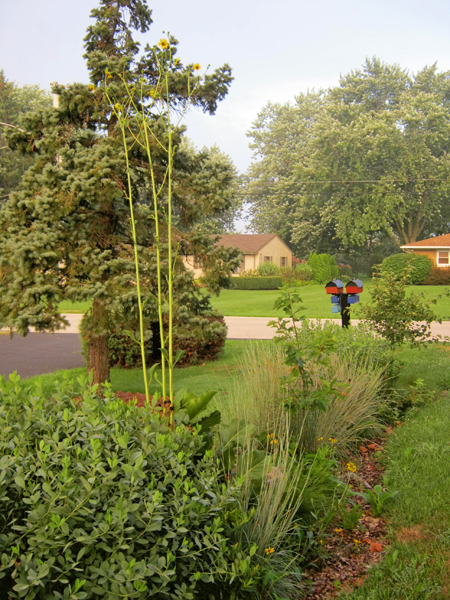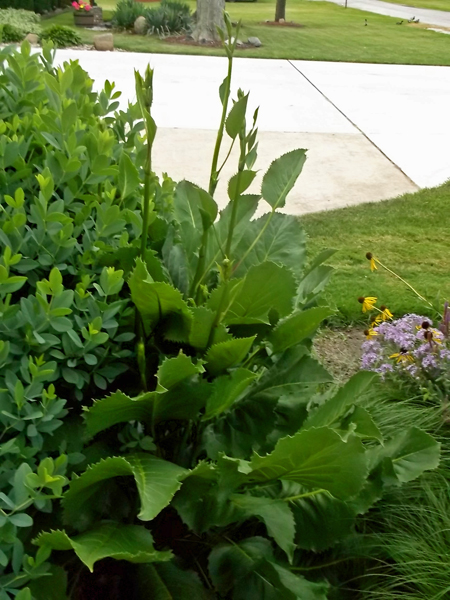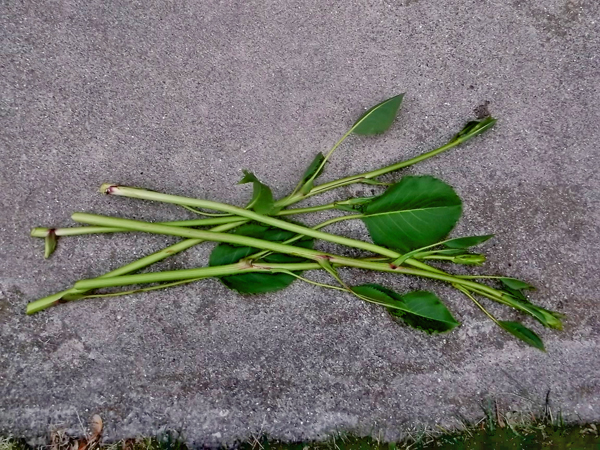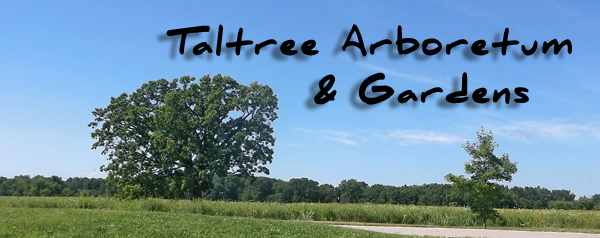
Opened in 1968 as a Playboy Club Hotel, the Frank Lloyd Wright inspired architecture of The Grand Geneva Resort & Spa lends itself well to the Roy Diblik designed entry garden. Installed in 2005/06, the garden evokes a Midwestern meadow full of bright flowers and billowing grasses. While not all of the 20+ species of perennials in this garden are native to the Midwest, most are not, Roy has shown, that “it doesn’t have to be all natives” to be sustainable. The garden does reflect a growing need for sustainable landscape design and creates an emotional connection for the viewer through “Representation of Place,” as Roy puts it.

According to Roy, ecological plantings are where landscape design needs to be. He would like to see an end to monocultures of Black-eyed-Susans and Purple Coneflowers, which too often leads to disease and death, as well as the “weed, woodchip, and replace” mantra of the landscape industry. Instead, he would like to see well designed landscapes, consisting of stable communities of plants, that are sustainable and create a pleasant garden.
Roy Diblik’s plantings are dense enough that weeds cannot compete with the perennials. He also believes in keeping the soil lean: “A lean soil supports fewer weeds.” Additionally, he feels that adding wood chips is not something that promotes plant health in perennials and should not be needed if they are happily growing in “closed, stable, communities.” He does, however, occasionally use leaf mulch in some of his gardens, for example, his gardens at the Art Institute of Chicago get an application of leaf mulch every three years.
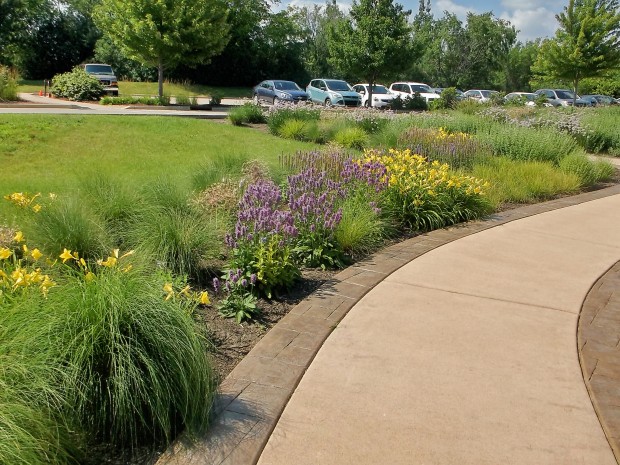
As can be seen in this garden, Roy keeps the plant palette limited (I counted approximately 20 species of plants), repeats many of the plants throughout the garden, and chooses plants the “respect their space.”
Roy has mentioned in his presentations, that the designer needs to consider the size and habit of the plants 3 to 5 years after planting, and that gardens need two years of nurturing, before gardening can begin. The old horticultural saying about perennials is that the first season, they “sleep,” the second year, they “creep,” and the third year, they “leap.” Roy plants in expectation of the third year, and beyond. But he is not a believer in “one and done,” rather, a garden (or landscape project) should be thought of in phases, and changes or additions should be planned for, in time.

In the above picture we see approximately a half dozen perennials repeated, each grouping knitted into the next, not simply one grouping next to another grouping. In the foreground, Allium angulosum ‘Summer Beauty’ ties into the yellow ‘Happy Returns’ Daylily, which in turn runs into the purples of various Veronicas. The seed heads of June blooming giant allium bulbs are still visable, and are part of the aesthetic of the garden. The bright green grass, Sesleria autumnalis, Moor Grass, fronts the walkway in the bed at left and complements the blue-green leaves of the Catmint, Calamintha nepeta ssp. nepeta, behind it. The Catmint as well at the ‘Summer Beauty’ Allium can be seen repeating in the rear of this image, as well. Spots of Stachys officinalis ‘Hummelo’ add a touch of royal purple to the mix.

In the largest section of the garden, the mixture of ‘Summer Beauty’ and Catmint can be seen with a large swath of purple ‘Hummelo’ behind, along with the taller Purple Coneflower, the misty blue Russian Sage, and the yellows of the ‘Happy Returns’ Daylilies, Coreopsis, and Achillea. In the distant background is Calamagrostis x acutiflora ‘Karl Foerster’ Feather Reed Grass. Various blue Salvias, past flowering in this photo, played a major color roll, earlier in the season. Plant shape, texture, and height play as much of a roll in this composition as does the color of the flowers.

Above, Sesleria autumnalis, Moor Grass; Calamintha nepeta ssp. nepeta, Catmint; Salvia‘Blue Hill;’ and Stachys officinalis ‘Hummelo,’ growing together as part of a happy and beautiful plant community.

Sporobolis heterolepis, Prairie Dropseed Grass; Allium angulosum, ‘Summer Beauty;’ and Echinacea purpurea, Purple Coneflower, intermingle nicely along the walkway.
The Plants Seen in Roy Diblik’s Garden
at The Grand Geneva Resort & Spa:
· Achillea x hybrida ‘Coronation Gold’ ‘Inca Gold’ Yarrow
· Allium angulosum ‘Summer Beauty’ Allium
· Allium purpureum bulbs
· Allium schoenoprasum ‘Schnitlauch’ Dwarf Chives
· Amsonia orientalis ‘Blue Ice’
· Baptisia sphaerocarpa, Yellow Indigo
· Calamagrostis x acutiflora ‘Karl Foerster’ Feather Reed Grass
· Calamintha nepeta ssp. nepeta, Catmint
· Coreopsis palmata, Prairie Coreopsis
· Coreopsis verticillata ‘Golden Showers,’ ‘Moonbeam’
· Echinacea purpurea, Purple Coneflower
· Geranium x hybrida ‘Orion’ Hardy Geranium
· Hemerocallis x hybrida ‘Happy Returns’ Daylily
· Kalimeris incisa ‘Blue Star’
· Perovskia atriplicifolia, Russian Sage
· Rudbeckia fulgida, Black-Eyed-Susan
· Salvia ‘Wesuwe,’ ‘Blue Hill,’ ‘East Friesland’
· Sesleria autumnalis, Moor Grass
· Sporobolis heterolepis, Prairie Dropseed
· Stachys officinalis ‘Hummelo’
· Veronica sp. Speedwell



